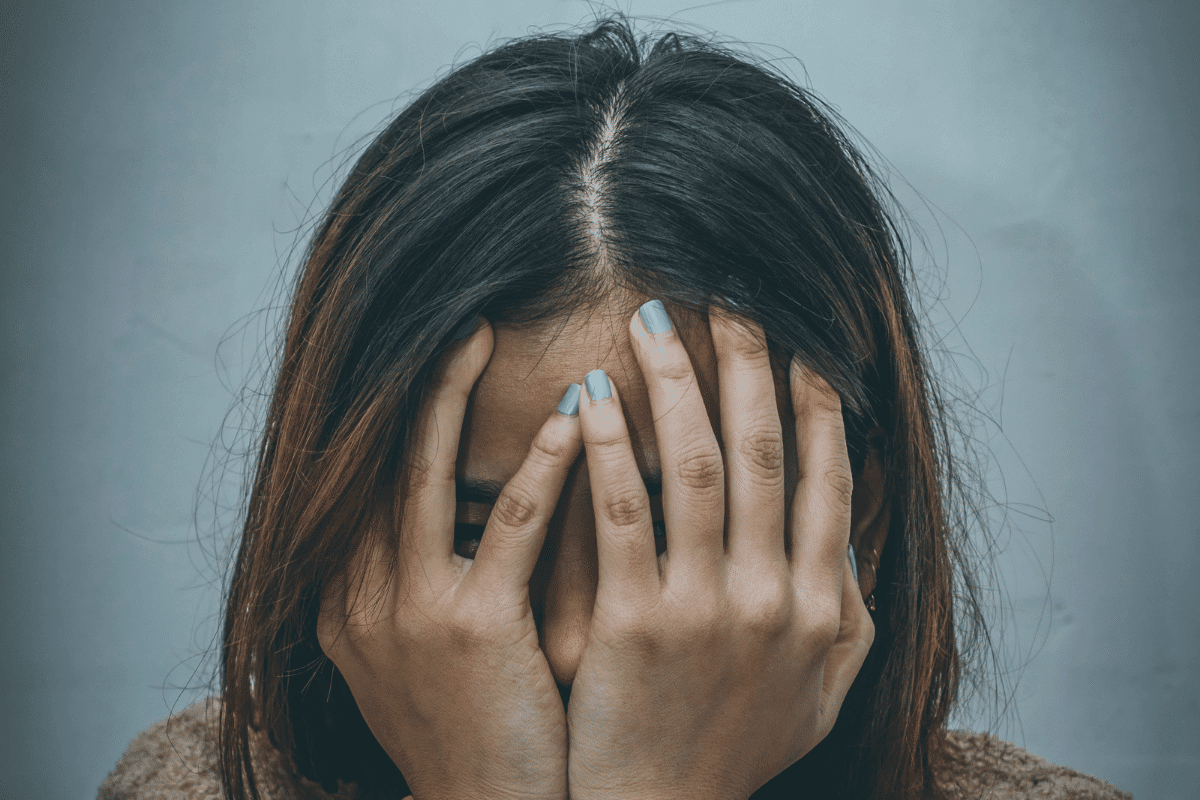How Your Inner Teenager Perpetuates Patriarchy and Holds You Back

We are experiencing unprecedented divisiveness between people as we are living through compounding catastrophes including a global pandemic, financial uncertainties, and climate change, to name a few. Even against that backdrop, it can feel shocking to see the current level of animosity, lack of empathy, and raw rage that is being widely expressed between people lately. It’s been said that the United States is an “adolescent culture,” primarily focused on our personal freedoms, but not as much on our collective responsibilities. Indeed, many of us are not operating as empowered adults, but as repressed, hurt, and scared versions of ourselves. Here’s why and how your inner teenager may be operating or activated as a subconscious protection mechanism—and how you can heal your inner teenager and improve your life.
Want to learn more? Check out my brand new mini-course “Healing the Inner Teenager”
In this article, I explore the surprising ways that the inner teenager may be showing up for many of us right now, and WHY that is happening, personally and collectively. This article is part 1 of a 2-part article series. After you finish reading this article, you can immediately read Part 2 in which I go into great detail on HOW we can nurture and embrace our inner teenagers and the many ways that our lives improve as a result. OK, let’s dive in!
Is Your Inner Teenager “At the Wheel”?
- Do you have moments when you find yourself feeling trapped and overwhelmed and then, as a result, feeling intensely angry, reactive, agitated, moody, or “on edge?”
- Do you experience moments when it feels impossible to stop negative thoughts?
- Do you find yourself unexpectedly lashing out at people in your life?
- This might sound like a strange question, but do you ever find yourself thinking “I hate people!”
If any of this resonates with you, it’s possible that your “inner teenager” may be “at the wheel” in moments, impacting your ability to feel calm, see clearly, and take adult, empowered action.
The Difference Between Inner Teenager and Inner Child
The inner child is a living energy within us. She may appear at different ages at a given time depending on how events in our current adult lives may trigger unprocessed trauma-based feelings about our childhoods. The younger inner child is much more openly vulnerable and receptive to the love and guidance of our adult selves when triggered.
The inner teenager sub-self, on the other hand, can be tricky to know how to deal with because she is NOT as open and vulnerable; she may actually be combative and aggressive in response to pain and may reject the support she needs if she feels unvalued or unseen. Her energy may seem very similar to our adult awareness in moments as well, making it difficult to notice when we have blended with her.
As teenagers, we each had to negotiate: How do I fit myself into this patriarchal world while still holding onto my own true sense of self?
The teenage years are a unique period in our development when we transition from childhood into more adult-like behaviors and responsibilities. Teenagers feel intense internal pressures, from bodily changes, moods, and hormones as well as external pressures from the social world of parents and peers; the pressure to excel, to perform, measure up, and to fit in. So much is happening beyond our control on every level as teens. Yet, we were concurrently yearning for more autonomy, freedom, and respect as individuals as well.
The Intense Pressure of Being a Teenager Shapes Our Present Life
One could say that the teenage years are a time when we feel more intense pressure than ever to conform to patriarchal beliefs, values, and behaviors of the wider culture—which are generally top-down, male-centered, and image-driven.
For teen girls, the pressure intensifies to be a “good girl” to suppress our true feelings, and to present a pleasing, non-threatening appearance to gain acceptance and social approval. We start to confront the visceral reality of the injustices that define our lesser place in society compared to men, as well as the stereotypes and impossible standards that are generally expected of us. The world can feel cold, cruel, and overwhelming in moments. We learn that it is NOT acceptable for women to express anger openly, so the anger we may feel about this “loss of self” during this time also goes underground and can only be expressed covertly and/or projected onto others as a form of release.
We learn that men can have power directly but women can only access it indirectly.
As teens, we may have experienced intense shame for how we didn’t necessarily fit in with the world and had to develop a “false self’ to cope with and defend our true selves from a culture based on comparison, judgment, competition, misogyny, image, and superficiality. Developing a false self is a form of emotional self-preservation to help us get through situations in which it feels unsafe to be authentic, real, and true. All of us do this to some degree to adapt to a culture that values men over women.
For many, starting in middle school or high school, the social scene among peers can feel at times like a battlefield, a fight for the survival of the fittest. The hierarchies of social comparison and competition define who is on top and who is at the bottom. There’s a sense of exposure, fear, and shame with new rules that have to be learned quickly. In a superficial, image-driven, capitalist, white-supremacist culture, we learn that we have to distance ourselves from our feelings, to toughen up in order to survive, to hide what we really feel and think in order to fit in.
Shame and Your Inner Teenager
Childhood Shame may become more solidified and internalized in the teen years:
- Shame for how your body didn’t fit the impossible standards. Intense fear about not measuring up.
- Shame for your natural needs and boundaries as a girl, which is belittled by the world at large.
- Shame for having anger as a teen girl which seems to have no safe place to be felt and seen as valid.
- Shame for feeling helpless and powerless in moments about so many things out of your control.
- Feeling pressure to have it all “together” with little safe place to decompress from the pressure.
- Shame for having a family life that may not feel safe or doesn’t meet the stereotype.
Trauma and Your Inner Teenager
Trauma or neglect in teen years can cause chronic distress and cause us to compensate in a variety of ways:
- Growing up too fast because adults could not take care of us. Adults didn’t feel safe.
- Pressure to appear older and more “together” than we actually feel due to some degree of neglect.
- Appearing aloof and being emotionally distant because vulnerability feels scary and unsafe and/or because the adults feel unreliable, shaming, or aloof to us.
- Feeling contempt and distrust of adults because we are disappointed by their lack of courage and lack of integrity; rebelling or acting out to express anger at them.
- Manipulation as a form of power, such as lying and people-pleasing to get our needs met and to avoid conflict because direct communication has been discouraged or not modeled by adults around us.
- Shaming others as a way to feel in control or important and as a means to defend against our own feelings of shame (projective identification).
- Chronic hypervigilance and fear, resulting in rigid beliefs and perfectionism.
All of these are innocent strategies we may have employed as teenagers to survive, get our needs met, and protect ourselves when we felt unsafe and unloved to some degree. These strategies may shape how we act or react as adults.
Your Inner Teenager Learned Strategies to Survive
To conform to a patriarchal world we needed to develop survival strategies and some degree of a “false self.”
For a mother of a teenager, the task is to provide a sense of belonging and safety AND also a sense of respect for a teen’s growing need for autonomy and freedom. If we had healthy, consistently loving, reliable adults around us, who cherished and nurtured us WHILE also respecting our growing need for individual autonomy, we were better equipped to navigate the choppy waters of growing up in a patriarchal world, thereby retaining more of a connection to our true self over time. There would be LESS of a need to develop a false self to protect the true self from the larger world. If that balance between nurturing and autonomy is off, what I call the “mother gap”, then a robust false self is created to emotionally survive, pushing the true self further into shadow.
As teenage girls, we may have felt our relationship with our mothers start to shift to being more distant, strained or rocky, without necessarily knowing why. We may have felt our mothers being increasingly more hostile, jealous, distant, triggered, disinterested, or unloving around us.
Mothers May Add to the Pressure (Instead of Protecting You From It)
Our mothers may have actually added to the intensity of pressures we felt instead of being a safe place from those pressures. Rather than protect us or teach us about the injustice of the patriarchal culture, our mothers may have actually reinforced the shame we felt in a variety of ways. For better or worse, our mothers modeled to us how to live in a female body in a world that’s hostile to us. To whatever degree she internalized patriarchal beliefs and values herself, she would likely pressure us to do the same; in the best of situations, as an intention of helping us by survive the world and in the worst of situations, as a form of perpetuating the abuse or neglect on us that she herself endured.
Many of our aging parents grew up in patriarchal “top-down” homes themselves, and may have expected us to also “fall in line.” To our parents, the top-down approach may have seemed like simply “the way things are.” It takes much courage and effort to do the inner work necessary to parent differently. For these more “old school” parents, a teen’s natural testing of boundaries may have triggered them and they may have further shamed the teen as a result.
Parents May Reinforce Painful Messaging to Teenagers
Parents may reinforce the painful pressures of teen years by sending (overt or covert) messages like:
- “Don’t do or be that! What will other people think?” (hollow, image-driven)
- “You have to reflect well on me, BUT don’t you dare surpass me.” (power-over)
- “There’s always a winner and a loser, and as the parent, I always win.” (power-over)
- “You’re too sensitive!” (shame for feelings)
As teen girls we may have internalized beliefs like:
- A good girl can’t be mad. I have to hide my true feelings to be loved.
- I have to lie to make people happy and get what I want.
- I have to be perfect OR I’m worthless.
- I have to be on guard always and anticipate what others want me to be.
- No one will love me if they know the real me.
- I feel out of control. I might as well act out and hurt myself.
- I can’t deal with this. I need relief RIGHT NOW! (binge or act out)
- I’m so angry I could explode. I will find a way to make them pay.
If the neglect and trauma persist in our teen years, the traumatized inner teenager may develop into a more rigid, defiant “protector self” that persists into our adulthood.
The inner teen/protector self can create many problems. The main problem is that the distressed inner teenager thinks she is protecting the true self when in fact, she is perpetuating the old patriarchal beliefs she inherited and is actually harming herself without realizing this. And because the inner teenager can seem very similar to our adult awareness, it can be tricky to notice when she may have “taken the wheel” of our system. The rebellious inner teenager can be self-destructive to our adult selves without inner mother guidance.
How The Inner Teenager Showed Up In My Own Romantic Relationships
To make it even more complex, sometimes the inner teenager may also be feeling rage at the adult self for some form of internal neglect. For example, in one of my previous romantic relationships, I was scared to set boundaries due to my upbringing that taught me that boundaries threaten the connection so I stayed silent while I was feeling invaded by my partner’s needs. This was increasingly triggering my inner teen’s sense of being invaded and unsafe due to my trauma history with my mother. When I was triggered and very stressed for other reasons, I didn’t realize that I was dissociating when I needed to be speaking out in self-protection.
This disassociation was a form of abandoning my inner kids as there was no adult awareness present; I was merged with them due to the intensity of stress I was experiencing. Eventually, my inner teenager would lash out at my partner in rage and try to shame them as a last-ditch effort to communicate my need for space, since my adult-self/ inner mother was not at the wheel. My programming to NOT set boundaries caused me to self-abandon and my inner teenager lashed out in an effort to protect myself. I was shocked to hear my mother’s shaming messages coming out of my mouth, in an attempt to get space from my partner.
This was a wake-up call for me that my adult needed to take the wheel back from my teen. When I looked deeper and listened within to what was going on, I realized that I had been resisting taking empowered adult action to respectfully set boundaries because on some level, I was still “waiting for the good mommy” in my partner to do it first; I was resisting “being at the wheel” in my adult position because I had been erroneously conflating inner mothering with the exhausting burden of being a parentified daughter, who had to grow up too quickly. It took time for me to eventually see that being my adult self (my inner mother taking care of my inner children) is NOT a burden, but freedom because there’s an internal harmony, integrity, and buoyancy when the inner kids are energetically “tucked in.” Without the inner mother at the wheel, there’s a chronic background baseline of exhaustion and tension inside. I was amazed to feel how much energy, joy, and inner calm emerged when I committed to regularly showing up for my inner children, especially my inner teen.
In Stress, We Default to Patterns Learned In Childhood
Times in our adult lives when our adult awareness may “merge” with our inner teenager:
- When we feel intense pressures in our daily lives
- When we feel trapped, the stress is ongoing, and it feels like there’s no end in sight
- When we feel overwhelmed by fearful thoughts and narratives
- When we feel unsupported and unloved and unvalued by the people around us
- When our traumatic history (especially from teen years) is getting triggered by current events
- When it doesn’t feel safe to be vulnerable and ask for help
- When we actually feel out of control but feel pressure to display a facade of control
Looking at this list, it’s interesting that the nature of the challenges we face as adults at this moment in history is somewhat similar in theme to the challenges we may have faced developmentally as teenagers:
- A LOT of things are unknown right now about our future as a globe
- The stress is ongoing without a clear end in sight (as kids time seemed to go on forever)
- The world is changing and the rules of the new world are not clear yet (A time of transition)
- Relationships and support systems may be changing and may not be feeling as supportive as they may have been in the past
- Our nervous systems may feel overwhelmed by the pressure on social media of being bombarded with non-stop crises on the news
- The beliefs and values that we took for granted are becoming more unworkable and obsolete (similar to how as teens we had to leave childhood behind and adapt to a new world)
- The tension between belonging and autonomy is being activated. We may be re-examining our values and beliefs, which can cause conflict with people in our lives and institutions as well
How and Why Your Inner Teenager May Be Activated Now
When we are undergoing stress, our brain naturally defaults to our early programming to survive. In times of inordinate stress, like living through a pandemic, instead of being more vulnerable and authentic, we understandably may go into more of a fight/protector mode. If we are experiencing one or more of the above situations in the list, we are likely outside our “window of tolerance” and feeling dysregulated and much in need of our adult self or inner mother to calm, soothe and regulate our nervous system.
If we don’t recognize this and take action to care for ourselves, to slow down, relax and decompress, then it’s more likely that we will merge with our distressed “inner teen.” The inner teen, in particular, can go to battle with the inner teens of other people, and in general create turbulence inside your system through negative thoughts, sensation-seeking, and acting out.
This is the end of Part 1. Want to learn more about the inner teenager and how we can turn this situation around? Read Part 2 here!
In Part 2 of this article series I cover:
- What our inner teens actually need to feel safe and secure
- The many ways that a secure inner teen can transform your life
- How a secure inner teen can act as a powerful bridge to true presence
- Powerful Questions for Reflection
And before you go….




